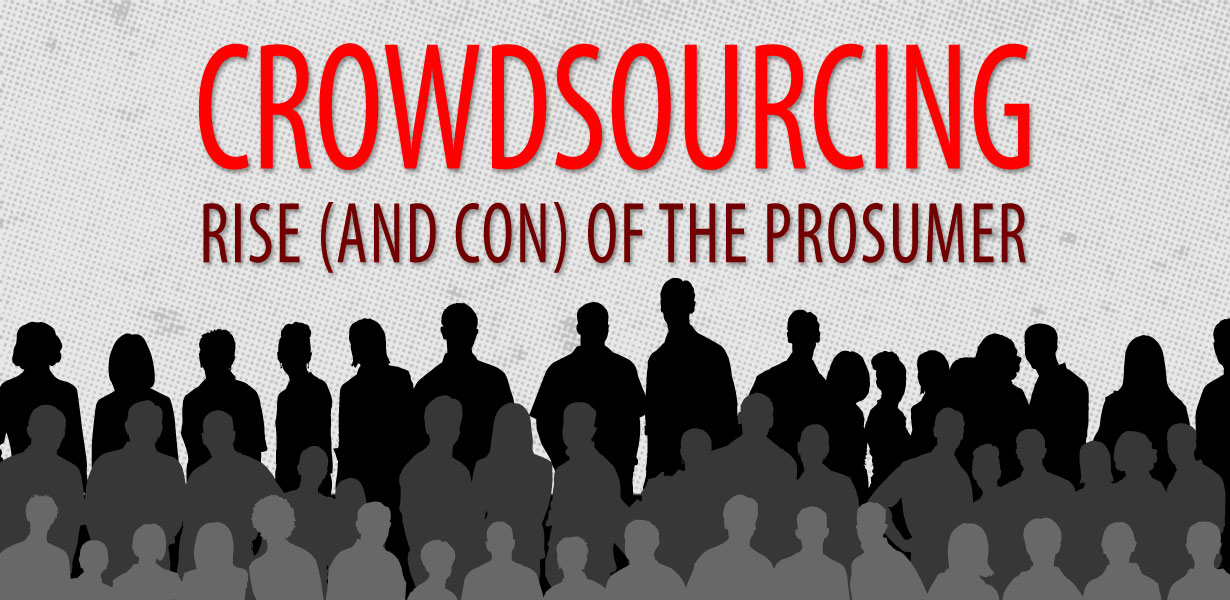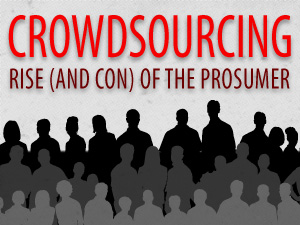Crowdsourcing: Rise (and Con) of the Prosumer
February 5, 2007
With the explosion of collaborative "Web 2.0" sites, a tipping point has been reached where the growth in user generated content is now fast outpacing traditional media. The devoted contributors to YouTube, Flickr, Digg, and Yahoo! Answers are the latest example of Alvin Toffler's prophetic "prosumer" (producer + consumer). In a post-industrial and postmodern society where everything has been mass produced and rehashed a thousand times before, the new frontier is mass-customization. And who better to generate this specialized content than the consumers themselves.
New niches and mashups that would never be covered by gigantic corporations are now being explored on a daily basis. Where else would videos like "Dice Stacking" be given equal air time to a global audience. The one question remaining is: will the huge global brands be able to maintain their grip by coercing their customers into providing free labor, or will technology and the free market shift the power and rewards into the hands of the individual and small business?
Background
The book The Third Wave was published in 1980 by the author Alvin Toffler. In it he described the evolution of societies in terms of waves:
| First Wave | Describes the first agrarian societies that replaced the nomadic hunter-gatherer cultures |
| Second Wave | Industrial societies based on centralized mass-production, mass-consumption, mass-eduction, and mass-media |
| Third Wave | Technology and information powered shift away from bureaucracy towards decentralized power and production |
One of the key points presented on in the Third Wave was the fall of the standardized "one-size-fits-all" model of industrial society. Mass production would be replaced by mass-customization in such areas as production, media, and education. This would be a difficult task for the monolithic vertical companies and while some would evolve and adapt, a new breed of competitors would rise to the task. Toffler coined the term "Prosumer" (producer + consumer) to describe how the consumers themselves would get involved in the production process. These consumers would either act as the designers for large corporations (by giving them detailed personal preferences) or they would become producers themselves using the power of technology.
Crowdsourcing
The term Crowdsourcing was coined by Wired magazine to describe business models that rely on cheap (or free) amateur labor. Collaborative websites like YouTube, Flickr, Digg, and Yahoo! Answers are a perfect example of crowdsourcing at work. Amateur directors, photographers, reporters, and support techs all provide user generated content that has generated billions of dollars of value for the sites' owners. YouTube itself was recently sold to Google for $1.65 BILLION. The viral aspect of this content and the ease of its spread on the net only ensures the growth of this trend. While many of these sites were started by individuals, the successful ones are quickly snatched up by the likes of gigantic corporations. And even though the founders are being rewarded handsomely, the users themselves are not.
Some may say that this is how the MSM (mainstream media) has always worked. Advertising money pays for viewers and the viewers are rewarded with free content. Broadcasters like NBC and CNN are the middlemen that invest in programming and distribution to facilitate the process. The key difference is that in the case of Web 2.0, users aren't passive viewers: they are the ones actually producing the content. The middlemen (YouTube, etc) may still fulfill the aggregation and hosting process, but in today's high technology world that can be easily replicated (on a smaller scale) by anyone with a website. The main thing they provide is a brand name, but again, that brand is built by the users.
Models of Compensation
Several models of compensation have evolved to address user's concerns. While some are happy just to have a global forum for sharing their ideas and making an impact, many treat their contribution as a part time job and want to be rewarded as such. There are different advantages to each model and there is nothing preventing sites from using them all in combination.
Revenue Sharing
Revenue sharing is by far the most obvious and popular model.
Sites like Squidoo pay a 50/50 split on advertising revenue to their "lens masters" or their favorite charities.
Even YouTube has proposed to follow this trend though the exact details have yet to be determined.
YouTube founder Chad Hurley addresses this issue as well as compensating artists whose works may be used in users' mashups.
Check out the details at this press conference video clip.
He claims they are only attempting this now because they have reached a critical mass, otherwise placing a price on contribution would just lead users to follow the market
and only post to sites where they will reap the greatest financial reward.
Paid Surfing
Paid surfing is an offshoot of revenue sharing where it is not just the content producers that gain benefits, but also those doing the viewing. For past analogies think of being paid to fill out surveys or listen to time share pitches. Companies like AGLOCO (and its original incarnation AllAdvantage) combine this idea with the viral nature of the web and human nature (greed). Part of their pitch involves multi-level marketing where you sign up your friends and take a cut of their commisions. Ultimately, many have criticized this as just the latest pyramid scheme.
Contests
Contests are another approach that often gain big publicity because of their lottery type payout. Out of thousands of contributors, one (or sometimes a few) people get a huge reward. The vast majority do not receive any compensation at all. Mainstream media versions of this approach include shows like American Idol, where the winner gets a signed recording contract. Online, there are numerous video contests where submissions could result in a contract or cash payout.
This approach also works well for scientific research as well. Netflix recently announced the Netflix Prize contest where the team who could improve their recommendation system by 10% would receive a million dollars. While there has been quick progress, many entrants have theorized that 10% may not be an attainable goal. So whether Netflix ever has to pay out the Grand Prize or not, they have gained more than $1M in publicity and free research.
Virtual Economies
The "game" Second Life is an all encompassing virtual world inspired by the fictional metaverse (or cyberspace) coined by authors Stephenson and Gibson. The term "game" only loosely applies to this service because there is no actual winning or ultimate goal. What Second Life provides is a 3D playground for people to carryout everyday activities, whether they are socializing or conducting real world business. A standardized currency and entire economic system provide its users with a platform to both create and sell content. Limited resources (land and primitive components) along with copy protection maintain the scarcity that is needed for the economy to thrive.
At this time there are no transaction related commisions (as with a service like eBay), so if a user creates and sells a program or item that generates millions of dollars, the only thing paid to Linden Labs (Second Life's creators) is a standard monthly fee for the account and any virtual land they require. So far, the metaverse is not as widespread or accessible as the 2-D web, but it is growing exponentially and big business has already started opening up virtual storefronts.
Conclusion
Without a doubt, the era of the Prosumer is well under way. User-generated niche content is gaining a larger percentage of viewership and big corporations are taking notice. What is left to be seen is which forms of contribution will eventually be favored and whether the power (and rewards) tilt in the favor of the individual.



